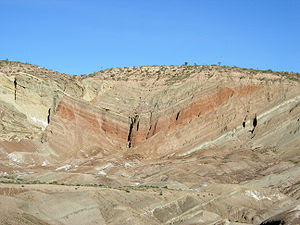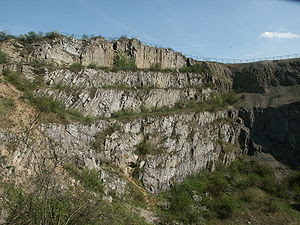The term fold is used in geology when one or a mound of firstly flat and planar shells, similar as sedimentary strata, are fraudulent or twisted as a result of plastic( i.e. endless) distortion.
Synsedimentary crowds are those due to rising of sedimentary material before it's lithified. crowds in jewels vary in size from bitsy wrinkles to mountain- sized crowds.
They do independently as insulated crowds and in expansive fold trains of different sizes, on a variety of scales. crowds form under varied conditions of stress, hydrostatic pressure, severance pressure, and temperature- hydrothermal grade, as substantiated by their presence in soft sediments, the full diapason of metamorphic jewels, and indeed as primary inflow structures in some igneous jewels.
A set of crowds distributed on a indigenous scale constitutes a fold belt, a common point of orogenic zones. Describing crowds A fold in Slichowice nature reserve in Kielce( Variscan orogeny) Rainbow Basin Syncline near Barstow, CaliforniaFolds are classified by their size, fold shape, miserliness, dip of the axial aeroplane. 2 D fold terms Looking at a fold face in profile the pack can be divided into a hinge portion and the branches. The branches are the sides of the pack and the hinge is where the sides join together.
The hinge point is the point of minimal compass of curve for a pack. The crest of the pack is the loftiest point of the fold face, and the trough is the smallest point. The curve point of a pack is the point on a branch at which the dint reverses, on regular crowds this is the mid-point of the branch.
3D fold terms The hinge points along an entire folded face form a hinge line. The trend and plunge of a direct hinge line gives you information about the exposure of the pack. To fully describe the exposure of a fold, one must use the axial face. The axial face is the face defined by connecting all the hinge lines of piled folding shells. If the axial face is a planar face also it's called the axial aeroplaneand can be described by the strike and dip of the aeroplane.
The axial trace is the line of crossroad of the axial face with any other face( ground, side of mountain, geological sampling). Eventually, crowds can have, but do n’t inescapably have a fold axis. A pack that can be generated by a fold axis is called a spherical pack. This term has been broadened to include near-spherical crowds. Fold shape It's necessary to convey a sense of the shape of the pack.

A pack can be shaped as a badge, with planar branches meeting at an angular axis, as cuspate with twisted branches, as indirect with a twisted axis, or as elliptical with unstable wavelength. Fold miserliness Fold miserliness is defined by the angle between the pack's branches, called the interlimb angle.
Gentle crowds have an interlimb angle of between 170 ° and 180 °, open crowds range from 170 ° to 90 °, tight crowds from 90 ° to 10 °, and isoclinal crowds have an interlimb angle of between 10 ° and zero, with basically resemblant branches. Fold harmony Not all crowds are equal on both sides of the axis of the pack. Those with branches of fairly equal length are nominated symmetrical, and those with largely unstable branches are asymmetrical.
Asymmetrical crowds will generally have an axis which is at an angle to the original, unfolded face which they formed upon. distortion style classes crowds which maintain invariant subcaste consistence are codified as concentric crowds; those which don't are called analogous crowds. analogous crowds tend to display thinning of the branches and thickening of the hinge zone. Concentric crowds are caused by warping which results from active buckling of the layers, whereas analogous crowds generally form by some form of shear inflow where the layers aren't mechanically active.
Fold types Anticline- USGS Monocline at Colorado National Monument Prostrate fold, King Oscar FjordAnticline direct, strata typically dip down from axial center, oldest strata in center. Syncline direct, strata typically dip toward axial center, youthful strata in center. Antiform direct, strata dip down from axial center, age unknown, or reversed. Monocline direct, strata dip in one direction between vertical layers on each side.
Chevron angular pack with straight branches and small hinges Prostrate direct, fold axial aeroplane acquainted at low angle performing in capsized strata in one branch of the pack. Depression generally monoclinal, result of discriminational contraction or dissolution during sedimentation and lithification. Ptygmatic crowds are chaotic, arbitrary and disconnected. Typical of sedimentary depression folding, migmatites and decollement detachment zones.
Causes of folding crowds appear on all scales, in all gemstone types, at all situations in the crust and arise from a variety ofcauses.Layer- resemblant shortening When a sequence of layered jewels is docked resemblant to its layering, this distortion may be accommodated in a number of ways, homogeneous shortening, rear faulting or folding.
The response depends on the consistence of the mechanical layering and the discrepancy in parcels between thelayers.However, the fold style is also dependent on these parcels, If the layering does begin to fold. insulated thick competent layers in a lower competent matrix will control the folding and generally induce classic rounded buckle crowds accommodated by distortion in the matrix.
In the case of regular alternations of layers of differing parcels, similar as sandstone- shale sequences, kink- bands,box-folds and badge crowds are typically produced. Rollover anticline Ramp anticline Fault- propagation fold Fault- related folding numerous crowds are directly related to faults, associate with their propagation, relegation and the accommodation of strains between neighbouring faults. Fault bend folding Fault bend crowds are caused by relegation along anon-planar fault.
Fault bend crowds do in both extensional and thrust condemning. In thrusting, ramp anticlines are formed whenever a thrust fault cuts up section from one detachment position to another. relegation over this advanced- angle ramp generates the folding. Fault propagation folding Fault propagation crowds or tip- line crowds are caused when relegation occurs on an being fault without farther propagation. In both rear and normal faults this leads to folding of the overlying sequence, frequently in the form of a monocline.
Detachment folding When a thrust fault continues to displace above a planar detachment without farther fault propagation, detachment crowds may form, generally ofbox-fold style. contraction crowds can be generated in a youngish sequence by discriminational contraction over aged structures similar as fault blocks and reefs.
Folding in shear zones Shear zones that compare to simple shear generally contain minor asymmetric crowds, with the direction of capsizing harmonious with the overall shear sense. Some of these crowds have largely twisted hinge lines and are appertained to as jacket crowds. crowds in shear zones can be inherited, formed due to the exposure ofpre-shearing layering or formed due to insecurity within the shear inflow.
Sedimentary folding lately deposited sediments are typically mechanically weak and prone to remobilisation. Depression folding When recessions form in inadequately consolidated sediments they generally suffer folding, particularly at their leading edges, during their site. The asymmetry of the depression crowds can be used to determine paleoslope directions in sequences of sedimentary jewels. Dewatering Rapid dewatering of flaxen sediments, conceivably touched off by seismic exertion can beget convolute coverlet.

Igneous intrusion The site of igneous intrusions tends to distort the girding country gemstone. In the case of high- position intrusions, near the Earth's face, this distortion is concentrated above the intrusion and frequently takes the form of folding, as with the upper face of a laccolith. Flow folding When gemstone behaves as a fluid, as in the case of veritably weak gemstone similar as gemstone swab, or any gemstone that's buried deeply enough, they generally show inflow folding of' analogous' style. similar folding is also a point of numerous igneous intrusions and glacier ice.
Folding mechanisms Folding of jewels must balance the distortion of layers with the conservation of volume in a gemstone mass. This occurs by several mechanisms. illustration of a large- scale crenulation, Glengarry Basin,W.A., an illustration of badge- type flexural- slip crowds.( edit) Flexural slip Flexural slip allows folding by creating subcaste- parallel slip between the layers of the folded strata which, altogether, affect in distortion. The stylish analogy is bending a phone book, where volume preservation is accommodated by slip between the runners of the book. Buckling generally, folding is allowed to do by simple buckling of a planar face and its confining volume.
The volume change is accommodated by subcaste resemblant shortening the volume, which grows in consistence. Folding under this medium is generally of the analogous fold style, as weakened branches are docked horizontally and thickened hinges do so vertically. This is achieved by pressure dissolution, a form of metamorphic process, in which jewels dock by dissolving ingredients in areas of high strain and redepositing them in areas of lower strain. crowds created in this way include exemplifications in migmatites, and areas with a strong axial planarcleavage.
Mechanics of Folding crowds in gemstone are formed in relation to the stress field in which the jewels are located and the rheology, or system of response to stress, of the gemstone at the time at which the stress isapplied.Rheology survived marble anticline at General Carrera Lake, ChileThe rheology of the layers being folded determines characteristic features of the crowds that are measured in the field. jewels which distort more fluently will form numerous short- wavelength, high- breadth crowds. jewels which don't distort as fluently will form long- wavelength, low- breadth crowds. Google Search Engine
Visit Official Home Page





0 Comments